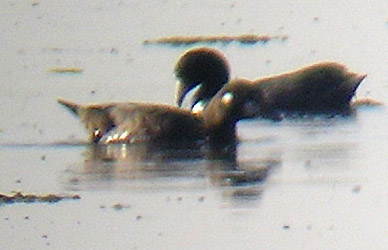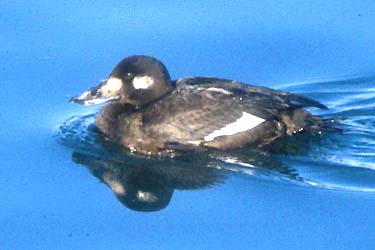| Rita Carratello and I were very lucky to hear about the report of a
Harlequin Duck at the Stockton wastewater treatment ponds on the morning
of 20 Nov 2005, and we stopped there on our way out-of-town from the Central
Valley Birding Symposium. Thanks to David Yee, Kurt Mize, and Margaret
[last name not known to us], we were able to arrange access through the
gates. Tim & Annette Manolis also arrived at the same time, and we
began searching the NE corner of the large eastern pond. I eventually found
the bird out near the center of the east end of the pond. It appeared to
be actively feeding by picking at the surface gunk, rather as the adjacent
American Coots were doing. At one point it stretched its body up and out
of the water surface and flapped its wings. I was able to determine that
all the wing feathers were in fresh condition, without any evidence of
molt in the primaries or secondaries. Because of this, and the otherwise
'female-type' plumage, I believed the duck to be in juvenal plumage. Given
that, I don't believe I can assign a sex to this bird. It could be a juv.
female or a juv. male.
I was told by Bruce Webb and others who congregated with us that the duck had been very flighty earlier. I didn't see it in flight but had a great back view of the entire stretched wings, as just described. I tried some digiscoping — below are my best two shots: |
||
|
||
|
||
 This
is presumably the same female Harlequin Duck in Monterey as the swimming
bird above, but two years younger: this shot is from Jan 2003. Note that
the white spots on the face are much reduced at this younger age: there
are actually three discrete spots — the well-defined rear spot, a more
poorly-defined front spot at the base of the bill, and a tiny white spot
just above and in front of the eye. I don't find this latter spot on any
White-winged Scoter photos I have reviewed, but it is apparent on Richard
Hall's photos of the Stockton bird. This
is presumably the same female Harlequin Duck in Monterey as the swimming
bird above, but two years younger: this shot is from Jan 2003. Note that
the white spots on the face are much reduced at this younger age: there
are actually three discrete spots — the well-defined rear spot, a more
poorly-defined front spot at the base of the bill, and a tiny white spot
just above and in front of the eye. I don't find this latter spot on any
White-winged Scoter photos I have reviewed, but it is apparent on Richard
Hall's photos of the Stockton bird.
Note also the entirely dark belly and the all-dark legs. From the literature, it appears that both White-winged and Surf Scoters have dull yellowish to brownish-red legs as young birds (Palmer, BWP). I think Joan Humphrey makes an excellent point. There are Atlantic and Pacific populations of both species [it is also
possible that Old World White-winged Scoters may be split as a separate
species in the future]. Palmer gives measurements of Pacific Harlequins
of bill lengths from 26-30 mm (avg 27.4, which a a mm longer than the Atlantic
avg), and flattened wing lengths as 195-211 mm. Weights of Alaskan adults
520-594 gm. in adult females. Some measurements for Pacific White-winged
Scoters (females) are bills 35-41 mm, wings 258-274 mm, and weights of
1548-1700 gm. Thus in body weight, scoters are 3X bigger than Harlequin
Duck. Wing length is also much longer in the scoter, but the shortest WWSC
female bill was only 5 mm longer than the longest female Harlequin bill.
Although generally the difference in bill length is very obvious, perhaps
the Stockton bird is on the long-billed side of HADU, which led to some
confusion. [Incidentally, weights of American Coot given by BWP range
320-660 gm; consistent with Harlequin but much smaller than a scoter.]
|
||
| I also believe that Smith's Longspur is ruled out on a suite of characters,
including belly color, facial pattern, and details in the upperwing coverts.
I rule out Eurasian Skylark as well, on bill color, lack of an eyering,
and tertial and back patterns. In addition, I believe the bird's
swimming behavior would be very unusual for either a longspur or a lark.
I thus conclude that we saw a juvenal-plumaged Harlequin Duck, a most
interesting bird for the Central Valley.
|



